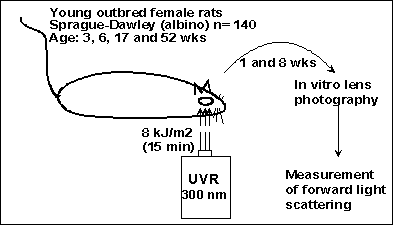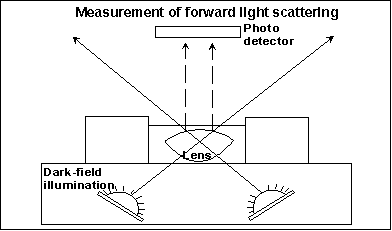Stefan Löfgren, Ralph Michael, Marcelo Ayala & Per G Söderberg
Poster submitted to the "Protection Against the Hazards of UVR" Internet conference Jan 1999
Abstract
Purpose. To investigate the effect of age and post-exposure time on ultraviolet radiation (UVR) induced cataract.Methods. 140 albino Sprague-Dawley rats, divided into the ages 3, 6, 17 and 52 weeks and two post-exposure time groups (1 and 8 w), were unilaterally exposed in vivo to UVR-300 nm. The dose incident on the cornea was 8 kJ/m2. The rats received mydriatic (pupil-dilating) eye drops before the irradiation. One week after exposure the lenses were extracted, photographed and the degree of forward light scattering (cataract) was measured.
Results. Preliminary data analysis showed that the younger rats were much more sensitive to UVR than the older rats. The radiation dose was so high that many lenses went totally opaque. The number of opaque lenses was higher after eight weeks than after one week post-exposure.
Conclusions. Young animals are more sensitive to UV radiation than old animals.
Introduction
Cataract is a major cause of blindness in the world. The surgical treatment of cataract where the lens is replaced by a artificial lens is very costful for the society. Scientists are trying to find the cause of cataract and possible medical treatments or preventive measures in order to reduce the suffering of the affected patients and to lessen the burden on the health care systems. Several hypotheses have been put through, among them the hypothesis that UVR in sunlight is an important risk factor for development of cataract. Epidemiological studies have shown a link between exposure to UV-B radiation in sunlight and development of cataract. Experimental studies confirm that UVR induces cataract. The safety levels for UVR exposure today are based on experiments with animals. There is however a lack of data on the age dependence in experimental UVR cataract. In this study the age dependence and post-exposure time are investigated in a rat model.Material
 |
Anaesthetized albino rats were exposed in vivo to UV-B radiation. The UVR source was a mercury lamp with water filter and a double monochromator set to 300 nm and 9 nm full bandwidth at half maximum. The dose, measured at corneal level, was 8 kJ/m2. Exposure time was 15 minutes. One eye in each rat was irradiated. Before the irradiation the rats received pupil-dilating eye drops. One or eight weeks after exposure the forward light scattering in the lenses was determined. |
 |
The lens was put in a cuvette filled with salt solution. The probing light from the dark-field illumination will in the case of a perfectly tranparent lens pass through the lens and not reach the photo detector. If there are scattering centers in the lens, the probing light will scatter and reach the photo detector. |
Results
Preliminary data analysis shows that| All groups developed pathologic light scattering in the exposed lenses. | |
| One week after exposure the two younger age groups had severe cataract while the older groups showed mild cataract. | |
| Eight weeks after exposure the youngest rats had developed totally opaque lenses. In the older groups the severity of cataract had increased as compared to one week post-exposure. There were 10-20% totally opaque lenses in the two oldest groups. |
Discussion
Younger rats developed more severe cataract. This is new information which not has been taken into consideration when current safety limits for UVR exposure was established. It may also have implications in ophthalmic laser treatment in children.Why are young rats more sensitive to UV radiation?
There are some factors which we believe may explain this. Suggestions on other possible factors are welcome!
| Young rats have a shorter depth of the anterior chamber than older rats. Consequently young rat lenses will receive more UVR. | |
| The lens size increase with aging. Therefore, in a young animal the UV radiation will reach deeper, relatively, into the lens compared to a older, and larger, lens. | |
| The transmittance of UV-B radiation is higher in young lenses. Larger volume of the lenses will then be reached by the radiation. | |
| The cell division rate is higher in younger rats. The cell divisions are located in the lenticular equatorial zone which is located behind the iris. Despite the relative shielding effect the iris has on the lens equator we believe that some UVR still reaches the lens equator. Tissues with high cell division rate are often more sensitive to radiation than tissue with no or low cell division rate. |